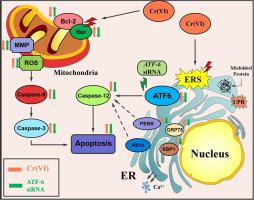Journal of Hazardous Materials ( IF 13.6 ) Pub Date : 2020-11-19 , DOI: 10.1016/j.jhazmat.2020.124607 Shuo Zhang , Xiaona Zhao , Jiajia Hao , Yiran Zhu , Yue Wang , Lumei Wang , Shuhua Guo , Hui Yi , Yongxia Liu , Jianzhu Liu

|
Hexavalent chromium (Cr(VI)) is a common heavy metal pollutant in environment and has been proved possessing the cytotoxicity. In this study, we aimed to investigate the role of activating transcription factor 6 (ATF-6) in apoptosis of chicken embryo fibroblasts cell line (DF-1) induced by Cr(VI). Firstly, DF-1 cells were exposed to Cr(VI) to establish the cytotoxicity model, then the cell apoptosis and ATF-6 protein level were analyzed. By silencing ATF-6 gene, changes of the apoptosis rate and apoptotic proteins were examined. To further explore the regulatory mechanism of ATF-6, endoplasmic reticulum (ER) stress, mitochondrial function, reactive oxygen species (ROS) level, as well as the related pathway were evaluated. Results showed that Cr(VI) can result in DF-1 cell apoptosis, along with mitochondrial membrane potential (MMP) reducing and ER stress. Meanwhile, ATF-6 silencing lowered the apoptosis rate and ER stress level, showing with the decrease of XBP-1, PERK, GRP78, Caspase-12, Cleaved Caspase-3 and the increase of Bcl-2. Further analysis found that ATF-6 silencing down-regulated ROS and caused MMP loss, suggesting that ATF-6 silencing inhibited Cr(VI)-induced mitochondrial damage. In conclusion, this study indicate that ATF-6 plays an important regulatory role in Cr(VI)-induced DF-1 cell apoptosis through the ER stress and mitochondrial pathway.
中文翻译:

ATF6在Cr(VI)诱导DF-1细胞凋亡中的作用
六价铬(Cr(VI))是环境中常见的重金属污染物,已被证明具有细胞毒性。在这项研究中,我们旨在研究激活转录因子6(ATF-6)在六价铬(Cr)诱导的鸡胚成纤维细胞系(DF-1)凋亡中的作用。首先,将DF-1细胞暴露于Cr(VI)建立细胞毒性模型,然后分析细胞凋亡和ATF-6蛋白水平。通过使ATF-6静音检测基因,凋亡率和凋亡蛋白的变化。为了进一步探讨ATF-6的调节机制,评估了内质网(ER)应激,线粒体功能,活性氧(ROS)水平以及相关途径。结果表明,Cr(VI)可以导致DF-1细胞凋亡,以及线粒体膜电位(MMP)降低和内质网应激。同时,ATF-6沉默降低了细胞凋亡率和ER应激水平,表现为XBP-1,PERK,GRP78,Caspase-12,Cleaved Caspase-3的减少和Bcl-2的增加。进一步分析发现,ATF-6沉默下调了ROS并导致MMP丢失,这表明ATF-6沉默抑制Cr(VI)诱导的线粒体损伤。总之,这项研究表明,ATF-6通过内质网应激和线粒体途径在Cr(VI)诱导的DF-1细胞凋亡中起着重要的调节作用。


























 京公网安备 11010802027423号
京公网安备 11010802027423号